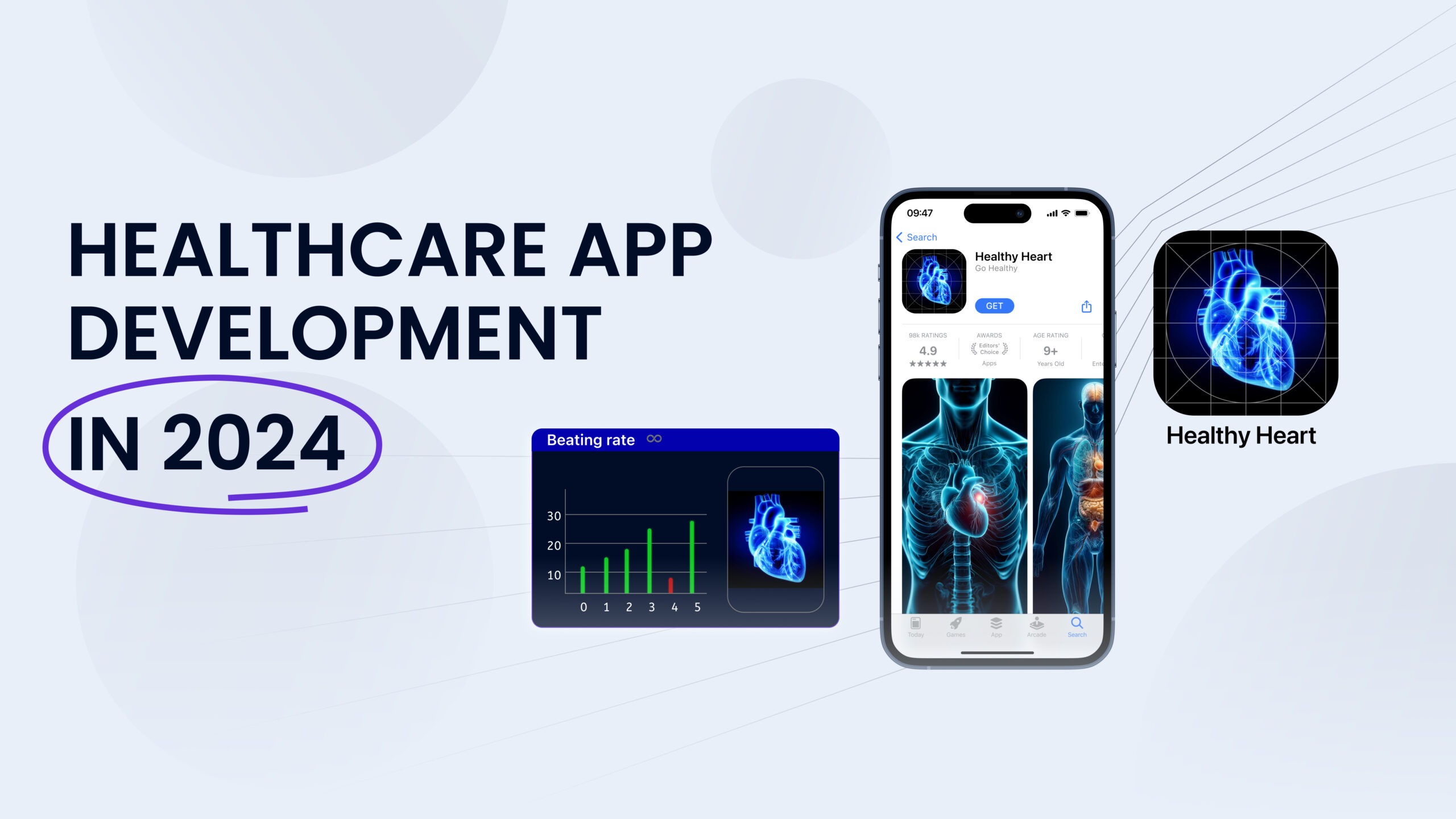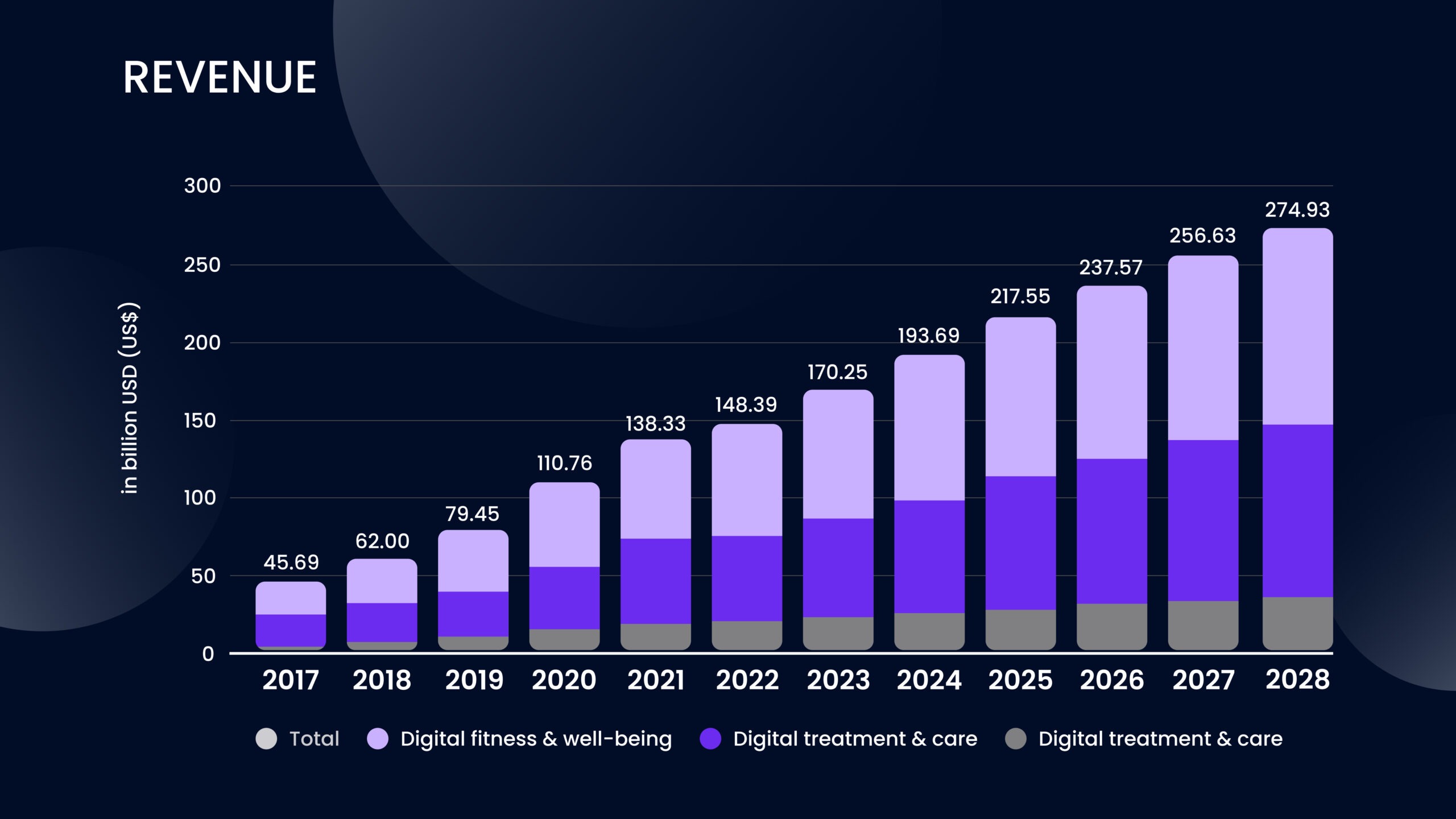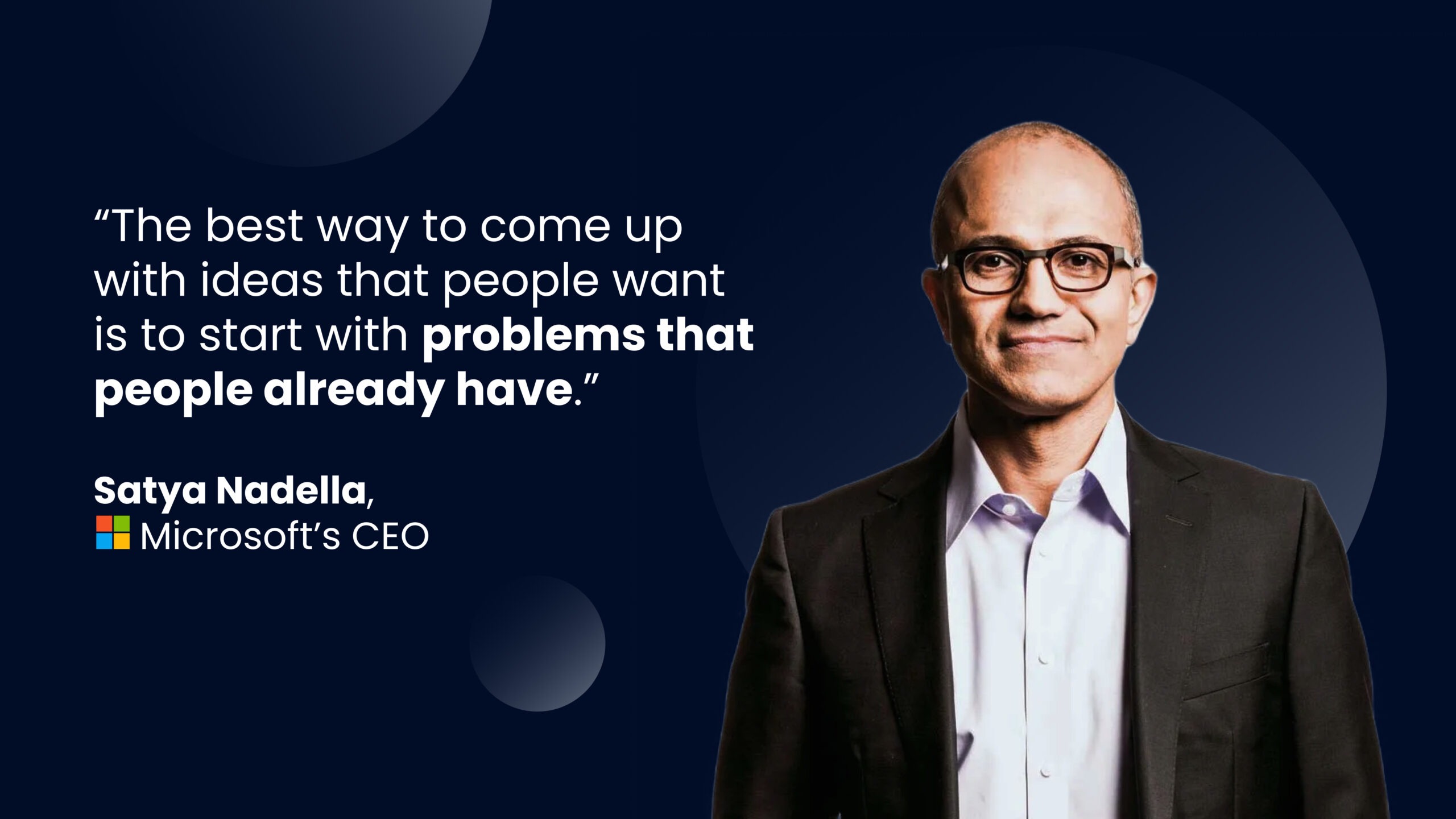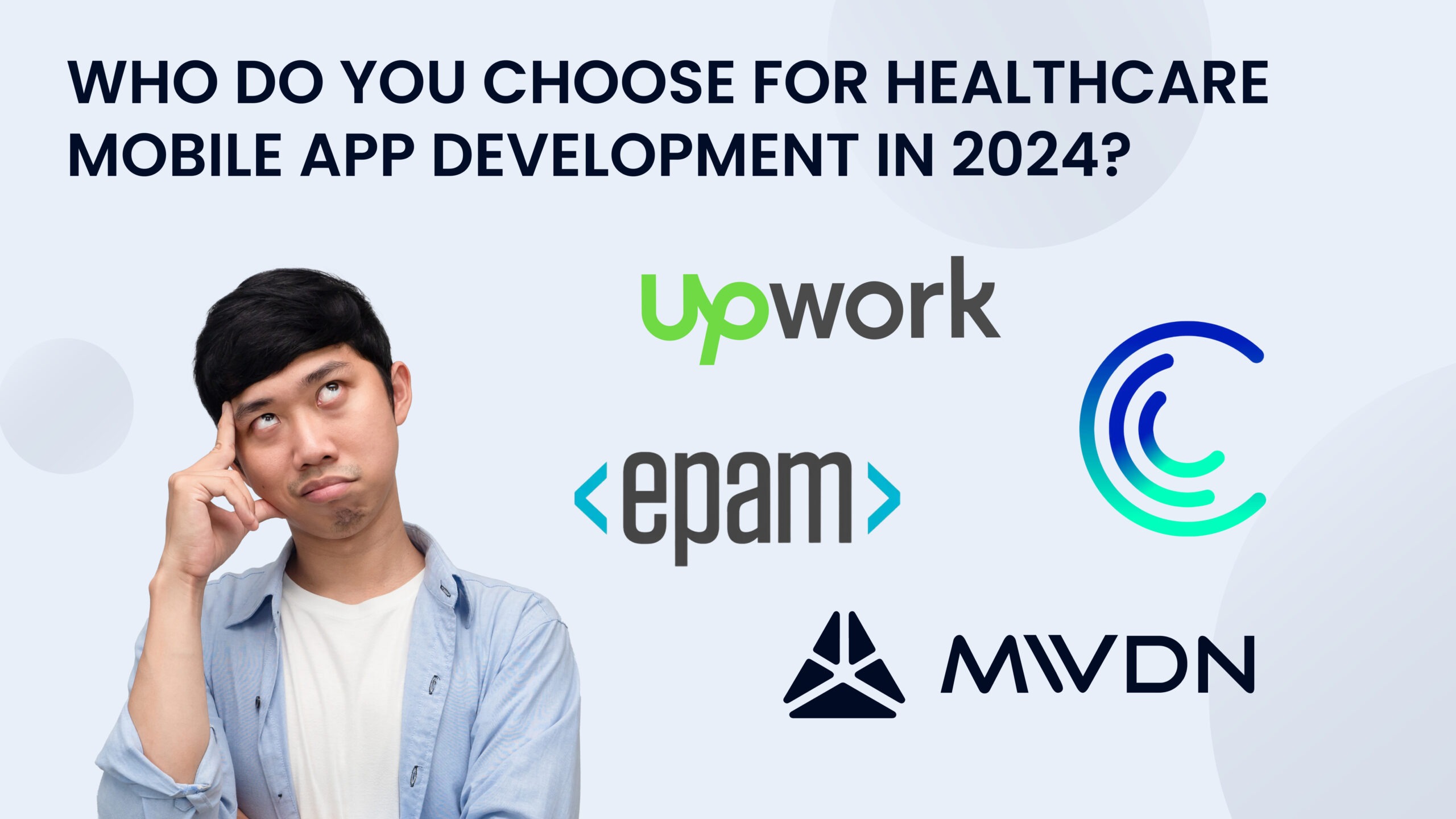
According to Statista, in Q3 2022, there were 54,546 healthcare apps in Google Play and 41,517 medical or health-related apps in the App Store. Plus, some private applications that were used only by specific healthcare providers and hence, were not in stores. Should this stop you from creating an app of your own?
Content:
- MedTech sector in 2024 – trends, statistics, and dynamics
- What are healthcare mobile app features?
- Mobile development guidelines for healthcare apps
- Healthcare app development costs 2024
- Healthcare application project – Example
- Summing up
Not in 2024. The demand for digital health options is so high that you will surely find your place on the market, especially if you follow our recommendations.
MedTech sector in 2024 – trends, statistics, and dynamics
The digital health and MedTech sector continues its rapid growth trajectory in 2024, driven by increasing healthcare costs, a growing global population, and rising demand for remote and personalized care. What exactly shapes the industry this year? Here are some numbers:
Market size and growth
According to Statista (February 2024 data), this year, digital fitness and well-being, digital treatment and care, and online doctor consultations are going to bring 193.69 billion US dollars in revenue. That’s a huge growth compared to 45.69 billion in 2017, and it won’t slow down.

Telehealth boom
After the COVID-19 pandemic, telehealth usage has seen new heights. From 49.9 billion US dollars in 2019, the market size of telemedicine will presumably hit 460 billion by 2030. As both patients and doctors embrace the convenience of virtual consultations, the trend is likely to continue even further.
AI in healthcare
Artificial intelligence is transforming healthcare by enhancing diagnostics, automating tasks, and facilitating personalized medicine. The global AI in healthcare market is expected to reach 188 billion U.S. dollars by 2030. Today, AI-powered tools are being used for analyzing medical images, predicting disease outbreaks, and developing personalized treatment plans. However, there is still a place for new apps and instruments based on AI in the healthcare sector.
Wearables and remote monitoring
Wearable devices and RPM solutions allow for continuous health data collection and real-time patient monitoring. The market for gadgets you can wear that track your health is expected to boom in the next few years. In 2021, the market size was $20.1 billion. By 2026, that number is expected to jump to $83.9 billion.
Industry dynamics
Investments. As venture capitalists recognize the potential of HealthTech, global healthcare VC funding is expected to surpass $100 billion this year. Hopefully, more money will fuel innovation and accelerate the growth of promising startups.
Security. As healthcare data becomes increasingly digital, there are more data security concerns than ever. Regulatory frameworks like HIPAA (US) and GDPR (EU) are enforced more stringently, requiring healthcare providers and technology companies to prioritize data protection.
Interoperability. The fragmentation of healthcare data across different systems remains a challenge. The industry is moving towards greater integration of EHRs to facilitate seamless data exchange and improve care coordination.
Your app might be the solution for all the new needs of medical personnel, healthcare institutions, and patients themselves. Here are some things you should consider before creating a healthcare app in 2024.
What are healthcare mobile app features?
Healthcare mobile apps come in many forms, but they generally fall into two categories: those designed for patients and those designed for healthcare providers. What would these target audiences expect from your app?
Here are some features in common for both TAs:
| Features for patients | Features for healthcare providers | |
|---|---|---|
| Appointment scheduling | Schedule appointments, view upcoming visits, receive reminders, and manage cancellations. | View patient schedules, manage appointments, and communicate with patients regarding scheduling changes. |
| Medical records access | Access and view portions of your EHR, including medications, allergies, lab results, and immunization history. | Access and update patient medical records, including history, diagnoses, medications, allergies, and treatment plans. |
| Telemedicine | Connect with a doctor or other healthcare professional virtually for consultations, follow-up appointments, or urgent care needs. | Conduct virtual consultations with patients, review medical records remotely, and provide diagnoses and treatment plans. |
| Prescription management | View current prescriptions, request refills, and receive notifications when refills are ready. | Electronically prescribe medications and send them directly to pharmacies. |
| Secure messaging | Communicate directly with doctors and other healthcare providers through a secure messaging platform. | Communicate securely with patients regarding appointments, test results, and treatment plans. |
| Wellness tracking | Monitor and record health vitals (blood pressure, weight, glucose levels), activity levels (steps, sleep patterns), and manage chronic conditions. | Remotely monitor certain patient health vitals and receive alerts for potential issues. |
| Bills | Payment function to view and pay medical bills conveniently within the app. | To review and submit medical bills electronically. |
There are some unique features for doctors and patients as well. For example, patients might also need medication reminders, so they can set and receive alerts to take medications on time and track adherence and educational resources to access health information libraries, articles, and videos on various medical conditions and healthy living practices.
Doctors and healthcare institutions will require lab results integration to receive and review patient lab results electronically and clinical decision support tools to support diagnoses and treatment decisions at the point of care.
Mobile development guidelines for healthcare apps
These are some of the mobile app development best practices that will work for the MedTech sector.
1. Know your audience and focus on their needs
“The best way to come up with ideas that people want is to start with problems that people already have,” Satya Nadella, Microsoft’s CEO, once said on a TED podcast in 2022. Prioritize a clear value proposition that solves a specific pain point for your target users.

2. “Fail fast, learn faster”
These are the words of Reid Hoffman, LinkedIn co-founder. LinkedIn. Don’t get bogged down in feature bloat. Start with a core set of features that validates your concept before extensive development.
3. Design and UX
Prioritize a user-friendly and intuitive interface that’s easy to navigate, even for those with limited technical experience. Keep it simple – your users should be able to accomplish tasks with minimal effort.
Consistency across interfaces will help a lot. Maintain consistent UI elements like buttons, icons, and menus throughout the app to create a seamless user experience.
Remember that over 5 billion people globally use smartphones. Ensure your app looks and functions flawlessly across different screen sizes and devices to reach a wider user base.
As a healthcare app, you have to think about accessibility for everybody. Ensure the app is accessible for users with disabilities, including features like screen readers and increased text contrast.
4. Data security and privacy
You will have to adhere to HIPAA compliance or GDPR compliance (depending on the region) just to get to your end user. Use relevant data privacy regulations to protect sensitive user health information.
Apart from that, implement robust security measures to safeguard user data from breaches and unauthorized access. Be clear and upfront about how user data is collected, stored, and used within the app.
5. Functionality and features
What unique benefit does your app offer compared to existing healthcare solutions? Offer a clear value proposition.
After proving that your MVP is accepted by your audience, think of integrating with existing EHR and other relevant platforms to improve data exchange and care coordination.
6. Technical considerations
Some surveys suggest that 40% of users abandon an app that takes more than 3 seconds to load. Optimize your app for smooth performance and responsiveness to keep users engaged.
Consider features that work even without an internet connection, especially for critical information or functionalities.
7. Testing
Rigorously test your app on various devices and simulators. Utilize real users (doctors and care geavers if your app is for healthcare providers) for beta testing to gather feedback before launch.
“Getting user feedback early and often is critical to building a successful product,” Twitter’s co-founder Evan Williams used to say. Continuously gather user feedback after launch to identify areas for improvement and iterate on your app.
8. What’s next?
After the launch, maintain the app with bug fixes, new features, and security updates to keep users engaged and ensure optimal performance. Utilize analytics tools to track user behavior within the app and gain insights for improvement.
Healthcare mobile app cost in 2024
Obviously, there is no one price that will fit every app development. You have to consider app complexity, the type of your development team, location (teams in North America and Western Europe typically have higher rates than those in Asia or Eastern Europe), and the features you want in your app.
The basic MVP of a healthcare mobile application with the simplest functions can cost you not that much, from $10,000 to $40,000. But what about a more sophisticated product? Here’s a quick breakdown of how much your average-complexity app might cost you, depending on the development approach you choose.

In-house development
You get full control over the project. Your development team has a deep understanding of your needs. There is a potential for long-term ownership. However, there is a high upfront cost for hiring and managing a development team.
Estimated cost range? $150,000 — $500,000+
Outsourcing
With outsourcing, you get to a wider talent pool, can expect lower development costs, and get access to specialized expertise. However, outsourcing means less control over the project, possible communication challenges, and potential for intellectual property concerns.
Companies like EPAM or CIKLUM are among your top choices if you opt for outsourcing. Consider outsourcing if you have a clear vision of what exactly and when exactly should be done on your project. Keep in mind that although outsourcing your healthcare application project is a great option, it might not be the first choice for small companies or startups in the first stages of development.
Estimated cost range? $50,000 – $300,000+ (USD)
Staff augmentation
It fills specific skill gaps in your existing team, provides flexibility and scalability, and has much less upfront cost than a full in-house team. Overall, this is the best combination of outsourcing affordability, delegation, and in-house control over development.
By choosing MWDN, you can expect various cooperation models, like time-and-material, dedicated teams, part-time developers, recruitment only, and many others, as we’re always open to your needs.
[Need to reinforce your development team with unique specialists?
Book a call with MWDN to see how we can help you!]
Estimated cost range? $75,000 – $200,000+ (USD)
Freelancers
Choosing freelancers is a cost-effective option for smaller projects. It gives access to diverse skill sets and offers flexible engagement options. However, there are always communication and project management challenges and a lot of quality control concerns.
Try Upwork to find IT-related specialists, including junior developers and strong software engineers. The platform offers vetted specialists and a variety of fee diapasons. Even though it provides mechanisms to guarantee safety for both clients and freelancers, it cannot guarantee that the work performed by a hired freelancer will be on the level you expected.
Estimated cost range? $25,000 – $100,000+ (USD)
How to choose the business approach that will suit you the best?
For starters, get quotes from different IT vendors. Our cost breakdown is very approximate and doesn’t consider the peculiarities of your particular project. Don’t hesitate to negotiate and ensure clear communication about project scope, timelines, and deliverables to avoid cost overruns. Overall,
- For complex healthcare apps with stringent security and regulatory requirements, in-house development or outsourcing to a reputable firm might be preferable.
- Freelancers or staff augmentation can be cost-effective options for smaller projects with a well-defined scope.
- In-house development may take longer due to team recruitment and onboarding, while freelancers can offer quicker turnaround times for specific tasks.
- If your team lacks the necessary technical skills, staff augmentation can provide access to the required expertise.
Healthcare application project – Example
What can your healthcare application project look like?
Let’s break down an average mental wellness app for college students. Let’s call it WM.
What is the problem of your target audience?
College students experience high rates of stress, anxiety, and depression due to academic pressures, social challenges, and financial worries. Traditional mental health services can be expensive, inconvenient, and carry a stigma on campus.
What is your solution?
WM is a mobile app designed to provide accessible and anonymous mental health resources for college students.
Key features of your healthcare app
- Mood tracking. Users can track their daily mood using a mood tracker and journaling functionality.
- Self-help tools. The app offers evidence-based self-help resources, including guided meditations, relaxation techniques, and coping mechanisms for stress and anxiety.
- Educational content. WM provides informative articles, videos, and quizzes on mental health awareness, managing stress, building resilience, and healthy sleep habits.
- Anonymous support groups. Users can connect with and offer support to other college students in a safe and anonymous online forum.
- Crisis resources. The app provides a directory of crisis hotlines, mental health professionals accepting new patients near participating universities, and on-campus counseling services.
- Goal setting and tracking. Users can set personalized goals for improving their mental well-being and track their progress over time.
- Incentive programs. The app can offer gamification elements and rewards for consistent app usage and completing positive mental health activities.
Your technology stack
- Front-end. React Native or Flutter for a cross-platform mobile app experience.
- Back-end. Node.js with a secure database to store user data anonymously.
- Cloud storage. Cloud storage services like AWS S3 or Google Cloud Storage for media content (guided meditations, educational videos).
- Push notifications. A push notification service to remind users of self-care activities and track progress toward goals.
Development process
Ideation and planning. Conduct user research with college students to understand their mental health needs and preferences for mobile app features.
Design and prototyping. Design a user-friendly and visually appealing app interface focusing on intuitive navigation and accessibility.
Development and testing. Develop the app using the chosen technology stack and conduct rigorous testing on various mobile devices and simulators.
Beta testing and user feedback. Release a beta version of the app to a limited group of college students and gather feedback to refine the app before a public launch.
Launch and marketing. Launch the app on the Apple App Store and Google Play Store with a targeted marketing campaign for college students and universities.
Post-launch and maintenance. Continuously monitor app usage, user feedback, and analytics. Address bugs promptly and release updates with new features and content based on user needs.
How are you going to monetize your app?
In 2024, there are four main monetization strategies: freemium, partnership, and in-app purchases.
1. Fremium is when you offer a basic level of features for free and a premium subscription tier with additional functionalities, like personalized coaching modules or access to live chat with mental health professionals.
For example, a fitness app could offer a basic free plan with limited workout routines, while a premium plan gives access to personalized workout programs, nutritional guidance, and live consultations with fitness professionals.
2. A partnership is a collaboration with universities and mental health organizations to offer the app as a free resource to their students and members.
You can also become a telemedicine advocate. Integrate features that enable video consultations between patients and healthcare providers. The app can charge patients per consultation or offer monthly subscription plans with a set number of consultations included.
3. You can also offer optional in-app purchases for specific self-help content packs or relaxation exercises.
A meditation app, for example, can offer free guided meditations for a set duration, with users needing to purchase in-app credits to access longer sessions or specialized meditations.
4. Targeted advertising. Display relevant ads to users based on their health interests and app usage. Avoid disrupting the user experience while using this monetization strategy.
Real-life examples of successful health apps
Whatever niche you choose—medical apps for healthcare providers, software for patients with particular conditions, weight loss apps, or mental health apps—get to know your possible competitors. Learn from them, copy their good features, and improve their lagging functions. Check out these apps for starters—they are great representatives of their niches.
Teladoc Health. Offers 24/7 access to board-certified doctors for consultations through phone or video chat. They have various subscription plans catering to individuals and families.
Calm. Provides guided meditations, sleep stories, and relaxing music. Its free tier offers basic features, with premium subscriptions unlocking a wider library of content, personalized programs, and deeper sleep analysis.
Omada. Focuses on diabetes management. The program combines a mobile app with coaching from certified diabetes educators. The app has subscription plans for individuals and employer-sponsored programs.
Summing up
2024 is the best time to create a new health-related or medical app, as the demand for this kind of software is high and continues to grow. Fitness trackers, weight loss apps, applications to help with specific conditions, medical billing and coding software, health insurance apps… the list goes on and on.
Fortunately, making an app is not that hard or expensive. The basic medical app MVP can cost 10,000 to 40,000 US dollars if you choose the right business model and delegate part of your processes to regions with lower direct labor costs.
Want to know more about ways to make an amazing healthcare app while staying on a budget? Book a call with the MWDN representative and learn more about our staff augmentation services.


